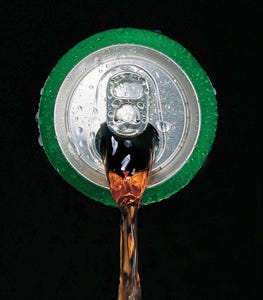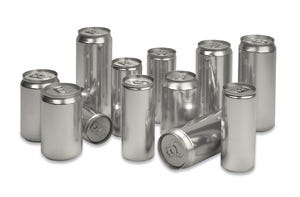Can-do attitude
January 30, 2014
|
Steel and aluminum cans hold everything from soup to shaving cream, paint to bandages, cola to fruit cocktail. Offering an effective packaging option, the metal can has evolved in recent years to become more innovative, lighter in weight and significantly easier to recycle.
Consumers have a high regard for metal packaging, crediting it as possibly the safest way to transport and store food and other products.
Safety and a long shelf life, in fact, are arguably the metal can's most notable and time-tested attributes. Since the material is rigid and robust, the can is unlikely to be torn, broken or crushed during shipping. Cans are hermetically sealed, so most of the time, microbes, oxygen, light and other agents cannot infiltrate, contaminate or degrade the contents.
In addition to protecting foods and beverages, however, metal packaging guards the consumer against potentially hazardous substances, such as solvents and cleaning chemicals.
The metal can was invented to provide a way to bring safe, ample food supplies to Napoleon's army on the battlefields. While the scenarios may have changed, the role that metal plays in protecting the supply of countless different goods remains unquestioned. This trust is a valuable asset for packagers to leverage.
The ability to infinitely recycle both steel and aluminum with absolutely no loss or alteration in quality is the highlight of the sustainability of metal packaging. Recycled in a true material-to-material loop (i.e., steel-to-steel), metals retain their original properties regardless of how many times they are recycled. Many other materials cannot make such a claim. As such, neither steel nor aluminum needs to be downgraded to less demanding uses after recycling. Both metals are permanently reusable. A beverage can could become part of a bicycle; an aerosol can or a metal cap could become part of a new car; or a soup can could become part of a kitchen appliance, or another can.
While other materials promote recycling, there is a limit to the number of times such materials can be transformed into new packaging, especially for applications involving direct food contact.
Metals—including packages—have a long-term, well-established recycling infrastructure due to the economic value of the materials. Through curbside collection programs, used metal cans are easy to acquire and even easier to separate from the household wastestream through a process of eddy currents or magnetic extraction.
Because steel and aluminum cans are made with a mixture of both virgin and recycled content, it is not possible to trace the recycled content of any specific can. Its recycled portion could have been reused hundreds of times before becoming that actual can. This explains the inherent sustainability of steel-to-steel and aluminum-to-aluminum recycling.
Currently, steel cans have a 62-percent recycling rate in the U.S. and 66 percent in the European Union (EU). Aluminum can recycling rates are at about 50 percent in both the U.S. and the EU, according to data from the Can Manufacturers' Institute. By comparison, plastic packaging is only at six-percent reclamation in the U.S. and 25 percent in the EU. The Environmental Protection Agency's ReCon model reports that steel cans have the highest recycling rate of any materials, followed by paper and paperboard, then aluminum cans.
Although primary metal production is relatively energy-intensive, recycling of scrap metals requires only a fraction of that energy. Steel recycling saves 70 percent of the energy required for primary production. Each ton of recycled steel saves 1.5 tons of iron ore and 0.5 tons of coal. Aluminum recycling saves 95 percent of the energy needed for primary production. Each ton of recycled aluminum saves more than four tons of bauxite, the primary ore from which aluminum is extracted.
This significant energy savings also translates to reduced greenhouse gas (GHG) emissions. Each ton of recycled steel saves about 1.875 tons of carbon dioxide, according to the International Iron and Steel Institute (IISI), and each ton of recycled aluminum saves approximately 10 tons of GHG emissions measured in CO² equivalents, according to the European Aluminium Association (EAA).
Abundant source materials
Aluminum is the most plentiful ore in the earth's crust, usually as part of bauxite. Iron (the primary component of steel) is the second most common ore. Aluminum and iron are the third and fourth most common elements on earth, after oxygen and silicon. Neither element is in any danger of being depleted. Use of the earth's abundant resources is far more sustainable than depleting limited materials.
Recycled steel reduces the need for virgin materials, which lessens both energy demand and CO² emissions. Global steel production is 1.2 billion tons, but only 1.5 percent of that total is used for packaging. At the present time, about 18 billion tons of steel are in use—somewhere, somehow—and therefore will be available in the future for recycling.
Less than 10 percent of the global production of aluminum is used for packaging. Since the start of commercial aluminum operations 150 years ago, 75 percent of primary production is still in use. That primary production is still available for future collection and additional recycling.
A can-do attitude
In general, cans offer distinct benefits, especially for food, beverage and aerosol products, in addition to the protection and long shelf life they provide. First, cans help to prevent product waste. According to the Industry Council for Packaging and the Environment (INCPEN), of the total energy expended in the food chain, 50 percent is used in food production, 10 percent on the packaging function, 10 percent on distribution to retail and 30 percent is used by the consumer in driving to and from the store and cooking/preparing the food.
The International Food Information Council estimates that, in developing countries, as much as 40 percent of available food products spoil before they reach hungry mouths. European surveys show that 30 percent of purchased food is thrown away without being consumed. Since cans protect contents so well against light, oxygen and microbe infiltration, they have the longest shelf life of any food packaging. Because of this, less product goes to waste.
Cans are also an economical form of packaging. First, they fill the fastest on packaging lines. In addition, because of their inherent strength, cans require only minimal secondary or transport packaging during shipment. Retorted canned product needs no refrigeration, or any ambient temperature control, during shipment and storage, reducing energy costs and CO² emissions.
Cans are economical for the consumer, too. Canned foods require minimal cooking times, if at all, which can further reduce energy use.
|
Metal cans provide material and design simplicity, making them quite efficient to manufacture. In most canmaking operations, the metal starts as a flat sheet and then is manipulated into the familiar one-piece canister. Shaped cans, which offer new design options, are becoming a popular alternative for brand distinction.
Downgauging cans
Lightweighting of both aluminum and steel cans is an ongoing process. Engineering technology today allows canmakers to reduce the thickness of can walls but still provide a high-performance container. Compared with 20 years ago, aluminum beverage cans are 28 percent lighter; steel food cans are 33 percent lighter; and tinplate aerosol cans are up to 18 percent lighter.
The can end, which is applied after filling, has likewise been substantially lightweighted. The SuperEnd® beverage end from Crown Holdings, Inc. (www.crowncork.com), introduced in 2001 specifically for the beverage market, has become an industry standard, with more than 150 billion ends produced. To date, Crown and its licensees who sell SuperEnd beverage ends have saved more than 37,500 tons of aluminum, more than 6,000 tons of coatings and more than 300,000 tons of greenhouse gases, which is the equivalent of the emissions from 16,500 automobiles per year. The SuperEnd beverage end's downgauged savings is the equivalent of switching from a 204 end to a 202 end. Because it is the same diameter as a standard 202 end, no modifications in packaging machinery are required. The materials savings are realized from a lightweighting of the end itself and the opening tab.
Metal packaging has earned its reputation through the factors of protecting the health and safety of consumers, preventing waste, using available natural resources, reducing material use, providing economic advantages and, most importantly, being recyclable. Metal packaging earns a star in sustainability for environmental protection, social equity and economic viability.
More information is available: |
Crown Holdings, Inc., 215/698-5051. |
You May Also Like




